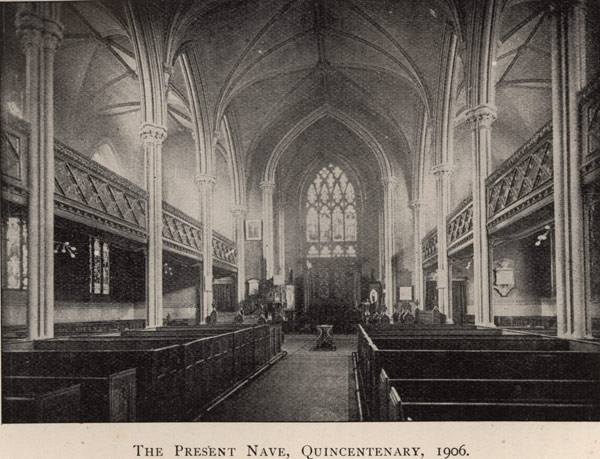
Oldham Parish Church
|
|
The area of Lancashire around Oldham was described in the Doomsday Book as waste land; by the late 17th century and early 18th century the area was rough moor land with scattered hamlets and villages. Many of these rural villages were bigger and more prominent than Oldham. The main difference with Oldham was that it was a village perched on the side of a hill on a route from Manchester to Huddersfield. A far greater significance was that it had a church and had it for many years. The area's clerics go back to the early eleventh century but there is no mention of a church building until it’s mentioned in a legal document. The deed mentions a William Scherewind who was described as a chaplain in Oldham in 1280. This hints at a building but it may have been an open air preaching cross. By 1476 there was a building as there is documentary evidence that it was in poor repair and needed work done; this implies that the church had been there for some time.
Diocese & Parish Prior to 1541 the Bishop of Lichfield had oversee of this area, this vast area made it very difficult for the Bishop to visit Oldham. This was to change and in 1541 it was moved to the Bishop of Chester; it was moving closer and it eventually arrived in Manchester, in 1847 where it still remains. Today Oldham is a parish itself, but originally it was part of the parish of Prestwich. The parish was fifteen miles long and four miles wide. This was to continue until Oldham became a parish in 1830. This parish details appear on maps and documents as “Prestwich-cum-Oldham.”. Oldham had three daughter districts, those of Crompton church built 1515, Chadderton church built 1758 and Royton church built 1757. These were responsible to Oldham as Oldham was responsible to Prestwich; this included raising money for the upkeep of the mother church. The “Advowson” (control) of the rectory lay with the Prestwich family until Richard of Langley of Agecroft married the Prestwich heiress. Building & Fabric The church that the Rector of Prestwich, Ralph Langley, restored in 1476 was typical of the period, square tower, long nave and short chancel. Internally there were north and South aisles, along with private chapels for the Cudsworth of Werneth Hall, Radcliffes of Foxdenton Hall and Hortons of Chadderton Hall. This medieval church served Oldham for many years. As the town grew, and as early as 1810, there was a call for a new church to be built. This was to cause the first conflict (the second later). The town was split between the modernists who wanted demolition and new-build, and the others who felt it was an act of vandalism. Time moved on and the argument began to be swayed towards the new-build camp. It was claimed that the structure was unsafe. This idea was further enhanced when the visiting Bishop of Chester Doctor Law said that the church was in a ruinous state. This was confirmed on the 3rd July 1825 when during the service the vestry chimney collapsed. The congregation panicked and fled. In the haste to get out it was said the many attempted to exit the windows. Many lost items of clothing; many were hurt and a Mr Peter Blain was severely injured. The fate of the church was sealed; permission was gained and demolition began. So much for weak structure, they had to blow up the church tower. As the plans of the young architect, James Barry (not knighted at this time), were developed they were found to be too expensive. The Manchester architect Mr Lane took over. The new church was opened on 12th December 1830. Here we encounter the second conflict. The daughter churches had to help fund this new-build and the expensive church was not received happily. The church was to continue serving the people of Oldham, with minor changes and additions to the fabric. The church was restored and redecorated in the 1970s. Mr Dykes Bower was engaged as the architect, He was Surveyor Emeritus to Westminster Abbey, His design returned it to its original Victorian state. Ministers The ministers of Oldham church are listed in the 'Miscellaneous' pages of this site, HERE; we will look at three prominent ministers. Rev. Thomas Hunt 1580-1611 his 31 year ministry was dogged by his rebellion against the church authorities, he was charged at various times with violating the liturgy and ceremonies of the Church of England, not wearing a surplice, not making the sign of the cross at baptisms, not meeting the dead at the church gate. As one of Lancashire’s leading Puritans he refused to conform, he may have been disliked by the church authorities, but as he remained Oldham’s minister for 31 years the people of Oldham must have liked him. Rev. Isaac Allen was the total opposite due to his attempts to return the church back to its Roman origins and his devoted adherence to the church authorities. In 1632 he was appointed Rector of Prestwich. During the civil war the local Presbyterian ejected from his living and imprisoned him. Rev. Robert Constantine was a staunch Presbyterian and was appointed to Oldham by the Manchester Classis; he soon clashed with the church patron the Asshetons of Chadderton, Constantine was suspended for several years returning in 1654. Constantine refused to sign the Act of Uniformity in 1662, for this Rev. Constantine was ejected from the living. He still wanted to preach in the Oldham area, as the church was out of the question. Constantine found a solution by preaching from a barn on the corner of Greenacres Road and a road we now named after the minister, Constantine Street. The ministry, started in a barn, became the present day Greenacres Congregational Church. by John Beever |
